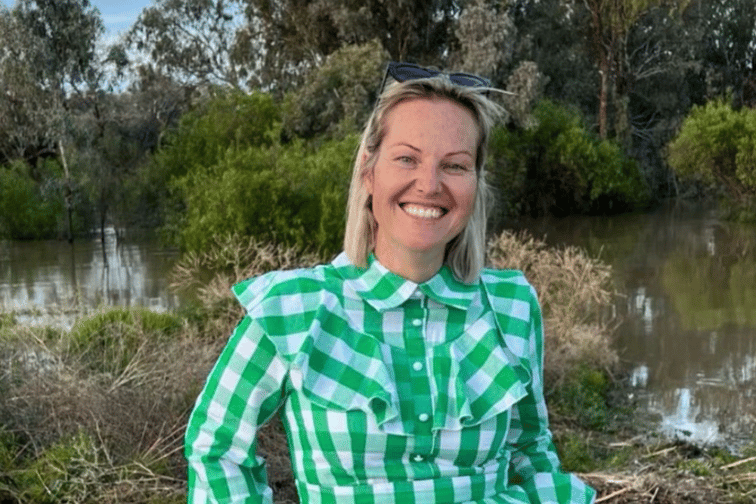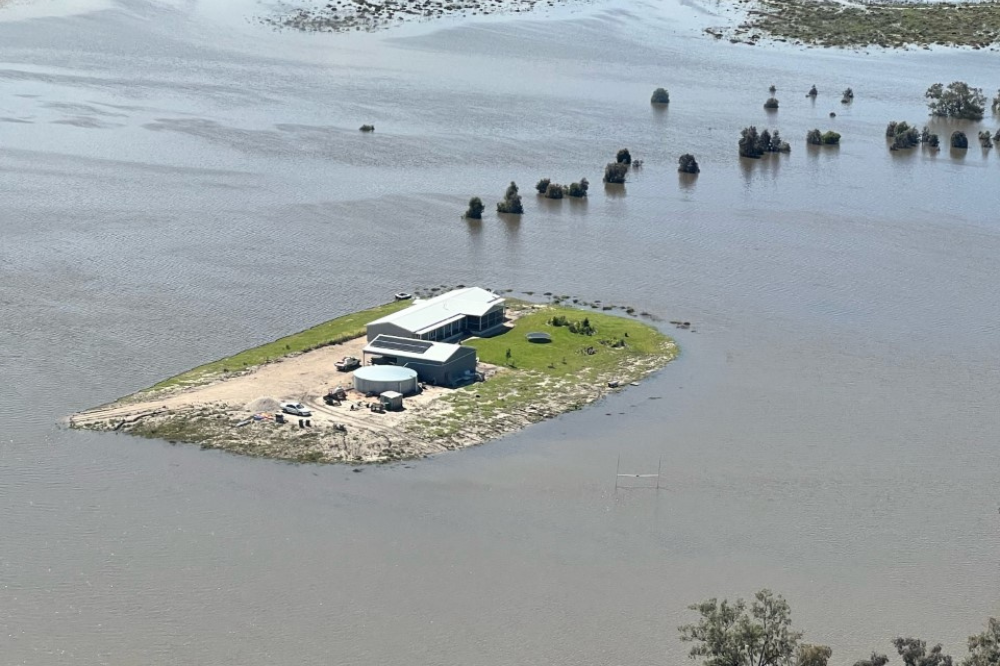

The incredible succession of repeated flooding events across NSW, South Australia and Victoria continues. One focus of the current inundations is northwest NSW where the outback town of Walgett is surrounded by water. However, in this town of two thousand residents there are unlikely to be many flood claims. Walgett’s levee has resisted floods since the 1950s, said Tiffany Loeve (pictured above), from MGA Insurance Brokers (MGA).
“The situation at the moment is that we are totally isolated,” said Loeve, a broker’s assistant, based in the Walgett area. “All roads in and out of Walgett are closed except for use by essential vehicles.”
Helicopters are flying in bread, milk, and medical supplies. In a jaw dropping picture provided by Loeve, her own home is like a small island in a lake (see picture below).

“We can boat to town,” she said. “[It] takes about 35 minutes.”
MGA has offices across Australia, particularly in regional areas. Loeve said the main business risks she works with are farm and crop.
“We can't insure crops against floods,” she said. “A lot of people will lose their crops, but it won't be anything that's claimable.”
MGA does offer commercial property coverage in Walgett, but Loeve’s not expecting any flood claims.
“The town is surrounded by a levee bank, which went in in the 1950s, so since then, there hasn't been any flooding in town,” she said. Loeve said this levee is around the whole town and many houses are right next to it.
However, despite this sturdy protection, Loeve said she has heard anecdotally that local residents have complained about big increases in the cost of their flood premiums.
“I think that when you look at our postcode, we are on two rivers, so people think that flood risk is high, but if you're in town with our levee bank, it's definitely not [a high risk],” she said.
Unlike the towns of Forbes or Moree, where rivers run through the middle of the town, Walgett’s rivers bypass it.
“We’re upstream from Forbes, so we won’t get Forbes’ water,” said Loeve. “We have the Barwon and the Namoi [rivers] and the Namoi has started to drop but we will get Gunnedah’s water - that was flooding last week.”
When more water arrives in the coming days, she expects the 1950s levee to protect the town.
“Our levee bank has done a great job and it's being patrolled - we've got four or five SES [State Emergency Service ] choppers here at the moment and we've got SES boats,” she said.
Loeve said the main issue for Walgett will be the length of time it takes for the water surrounding the town to recede.
“Our town is very safe, just very isolated and we're quite flat so it will take a while because the water has nowhere to go and everything is so wet,” she said.
This week, emergency management minister Murray Watt called on insurers to lower premiums for customers in disaster-prone regions. The call came as the federal government significantly invests in infrastructure to minimise loss during extreme weather events.
At the Insurance Council of Australia's (ICA) annual conference, the minister emphasised the government's vow to spend up to $200 million annually on disaster mitigation projects, arguing that the investment must be reflected in lower insurance premiums.
“[The] government is doing what insurers told us was needed – a significant increase in mitigation investment,” Watt said at the conference, as reported by The Guardian. “Now, we expect the insurance industry to fulfil its end of the bargain.”
However, the Insurance Council of Australia’s (ICA) website shows that, just for the flooding across NSW and Queensland in February and March, insurers have paid out more than $5.5 billion in claims out of more than 230,000 claims lodged.
“We need to be investing at least a billion dollars a year more in flood levees, in raising homes, and ultimately, going back and fixing past mistakes,” said ICA CEO Andrew Hall to the ABC during a visit to flood stricken Tasmania last month. “There are areas of this country where houses were built that should never have been built, and we need to make sure moving forward that development isn’t approved in areas that are prone to flood.”
Allianz's claims data showed that 38% of home insurance claims resulted from extreme weather events. Since Australia moved into a La Niña weather pattern, the insurer has seen an 81% increase in weather-related home and motor insurance claims during the CAT season.
The insurer’s researchers also found that one quarter of respondents said they no longer tune into weather reports.
